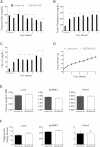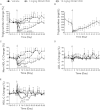ANGPTL3 blockade with a human monoclonal antibody reduces plasma lipids in dyslipidemic mice and monkeys
- PMID: 25964512
- PMCID: PMC4479335
- DOI: 10.1194/jlr.M054890
ANGPTL3 blockade with a human monoclonal antibody reduces plasma lipids in dyslipidemic mice and monkeys
Abstract
Angiopoietin-like protein 3 (ANGPTL3) is a circulating protein synthesized exclusively in the liver that inhibits LPL and endothelial lipase (EL), enzymes that hydrolyze TGs and phospholipids in plasma lipoproteins. Here we describe the development and testing of a fully human monoclonal antibody (REGN1500) that binds ANGPTL3 with high affinity. REGN1500 reversed ANGPTL3-induced inhibition of LPL activity in vitro. Intravenous administration of REGN1500 to normolipidemic C57Bl/6 mice increased LPL activity and decreased plasma TG levels by ≥50%. Chronic administration of REGN1500 to dyslipidemic C57Bl/6 mice for 8 weeks reduced circulating plasma levels of TG, LDL-cholesterol (LDL-C), and HDL-cholesterol (HDL-C) without any changes in liver, adipose, or heart TG contents. Studies in EL knockout mice revealed that REGN1500 reduced serum HDL-C through an EL-dependent mechanism. Finally, administration of a single dose of REGN1500 to dyslipidemic cynomolgus monkeys caused a rapid and pronounced decrease in plasma TG, nonHDL-C, and HDL-C. REGN1500 normalized plasma TG levels even in monkeys with a baseline plasma TG greater than 400 mg/dl. Collectively, these data demonstrate that neutralization of ANGPTL3 using REGN1500 reduces plasma lipids in dyslipidemic mice and monkeys, and thus provides a potential therapeutic agent for treatment of patients with hyperlipidemia.
Keywords: angiopoietin-like protein 3; cholesterol; dyslipidemia; endothelial lipase; hyperlipidemia; lipoprotein lipase; triglycerides.
Copyright © 2015 by the American Society for Biochemistry and Molecular Biology, Inc.
Figures





References
-
- Merkel M., Eckel R. H., Goldberg I. J. 2002. Lipoprotein lipase: genetics, lipid uptake, and regulation. J. Lipid Res. 43: 1997–2006. - PubMed
-
- Wang H., Eckel R. H. 2009. Lipoprotein lipase: from gene to obesity. Am. J. Physiol. Endocrinol. Metab. 297: E271–E288. - PubMed
-
- Shimizugawa T., Ono M., Shimamura M., Yoshida K., Ando Y., Koishi R., Ueda K., Inaba T., Minekura H., Kohama T., et al. 2002. ANGPTL3 decreases very low density lipoprotein triglyceride clearance by inhibition of lipoprotein lipase. J. Biol. Chem. 277: 33742–33748. - PubMed
-
- Ono M., Shimizugawa T., Shimamura M., Yoshida K., Noji-Sakikawa C., Ando Y., Koishi R., Furukawa H. 2003. Protein region important for regulation of lipid metabolism in angiopoietin-like 3 (ANGPTL3): ANGPTL3 is cleaved and activated in vivo. J. Biol. Chem. 278: 41804–41809. - PubMed
-
- Köster A., Chao Y. B., Mosior M., Ford A., Gonzalez-DeWhitt P. A., Hale J. E., Li D., Qiu Y., Fraser C. C., Yang D. D., et al. 2005. Transgenic angiopoietin-like (angptl)4 overexpression and targeted disruption of angptl4 and angptl3: regulation of triglyceride metabolism. Endocrinology. 146: 4943–4950. - PubMed
Publication types
MeSH terms
Substances
Grants and funding
LinkOut - more resources
Full Text Sources
Other Literature Sources
Miscellaneous

